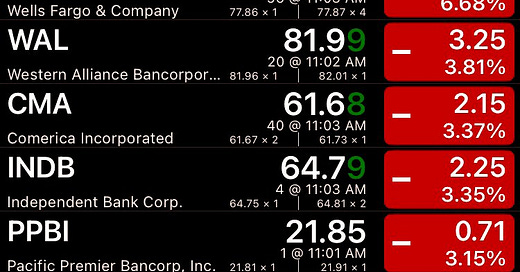America’s Banking System on the Brink: Your Money Isn’t Safe—Banks Are Insolvent and the FDIC Can’t Save You!
Branch Closures and Layoffs—The Shrinking Footprint of America’s Banks
Just understand 3 Basic Facts:
Total Deposits (All Commercial Banks):
1. $18,319.2$ billion (or $18.3$ trillion), seasonally adjusted as of July 2, 2025
2. FDIC has about $150 Billion
3. For every $10,000 in the bank you would get about $750
With Wells Fargo showing they borrowed nearly $200 billion to stay in business for the quarter investors are starting to panic on which banks are insolvent.
Have you ever wondered what truly happens to your money after you hand it over to the bank? You might imagine a vault with your cash awaiting your return, but the reality is far more unsettling—and it carries dire consequences for every American.
The United States is drowning in over $37 trillion of national debt, a figure so large it defies imagination. But what’s truly alarming is that nearly $11 trillion of this debt needs to be refinanced in the very near future—and at much higher interest rates than before. How will our government handle this colossal weight as the price of borrowing ticks ever upward?
When was the last time you considered what your bank deposit actually is? Contrary to popular belief, depositing money doesn’t mean the bank stores your funds in a labeled box for safekeeping. Instead, your deposit instantly becomes an unsecured loan to the bank. That’s right—your “safe” savings are legally just another debt the bank owes, and you, the depositor, are an unsecured creditor.
But what if a crisis strikes and everyone wants their money back at once? Here’s where the math becomes truly frightening. Take a look at the numbers: As of July 2025, Americans have parked approximately $18.3 trillion in commercial bank deposits. Meanwhile, the FDIC’s Deposit Insurance Fund (the backstop for your “insured” money) sits at only $129.2 billion as of the second quarter of 2024. Think the FDIC can step in and save the day for all depositors? Think again. That insurance fund covers barely 0.7% of all deposits. If even a tiny fraction of depositors demand their money back at the same time, the whole system unravels.
What about the banks themselves? Are they as stable as they appear? Beneath the surface, banks are buckling under the weight of bad loans and underwater investments, especially in sectors like commercial real estate where falling values and higher rates are fueling a looming default crisis. Imagine over $1 trillion in commercial real estate loans coming due while the underlying properties crater in value. Who’s holding the bag? Increasingly, it’s your neighborhood bank—and, by extension, you.
And just when you thought the system couldn’t handle more stress, layoffs are sweeping across industries—from tech giants to manufacturing and retail. Does this wave of job losses signal something much deeper is wrong with our entire economy?
The threats don’t end there. Look at the towering mountain of unfunded liabilities—Social Security and Medicare promises totaling more than $73 trillion, with no current funding plan in sight. What happens to these social safety nets if the wheels come off the financial system?
Now, take a step back and ask yourself: Is this the kind of backdrop where a nation can afford to fight five wars at once? The United States is not only financially embattled at home but entangled abroad as well—waging proxy conflicts with Iran through Israel, a grinding standoff with Russia via Ukraine, an escalating economic war with China, further economic hostilities with much of the world, and the quiet, relentless war on the American workforce, squeezed between inflation and rising taxes. Does any superpower survive being stretched this thin, both financially and geopolitically?
So what does all this mean for you, the everyday American? The hard truth is the banks do not have your money, at least not the way you think they do. Fractional reserve banking means that only a small fraction of deposits are kept as cash—if too many people come for their funds, the money simply isn’t there. If a real crisis sparks a mass withdrawal, we face a technical default, plain and simple.
Isn’t it time for a real conversation about the risks lurking in every corner of our financial system? How much longer can we pretend everything is fine when the numbers add up to such glaring vulnerability? More than ever, Americans need honesty, vigilance, and accountability. The warning bells are deafening—will you listen before it’s too late?
You have one choice to stay alive
Throughout history, silver and gold have stood as true stores of value. Unlike paper money, these precious metals cannot be printed or artificially created by governments. They bear no counterparty risk—holding physical gold or silver means you do not rely on a bank, institution, or government promise for their worth. For thousands of years, gold and silver have endured through wars, famines, disasters, and regime changes, always retaining their inherent value. In stark contrast, every fiat currency ever created has eventually collapsed, falling to zero over time without exception. This resilience cements their reputation as the ultimate safe haven assets.




